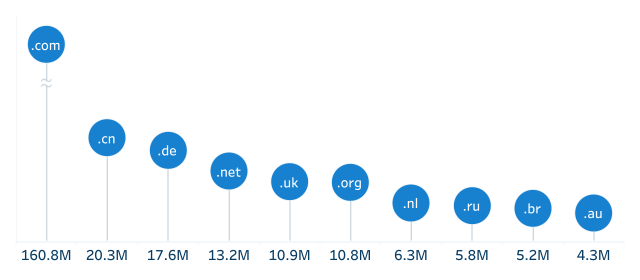How Many Domains Are There? Unraveling the Web’s Web of Domains
If Abraham Maslow were to redefine his “hierarchy of needs” today, we predict that the internet would claim a spot on the first or the second level. In a world dominated by websites and apps, the curiosity about the number of domain names (which form the foundation of websites) is only natural.
In this blog post, we’ll not only delve into the total number of registered domain names worldwide but also look at the diverse universe of domain extensions and how many of those exist too.
So, how many domains are there? Let’s find out!
How Many Domain Names are Registered?
VeriSign, the domain name registry for .com and .net domain names, plays a pivotal role in keeping tabs on domain name registrations. Their quarterly reports called the Domain Name Industry Brief (DNIB) serve as a beacon, guiding us through the ever-expanding digital landscape. According to their latest report in Q3 2023, the world boasts a staggering 359.3 million domain name registrations across all top-level domains (TLDs), also commonly referred to as domain extensions or domain endings.
Here’s a fun fact: With around 8.1 billion people on planet Earth, there are 359.3 million domain names. That translates to approximately 1 domain for every 22 individuals on the planet. We know that’s that correlation may not hold up to rigorous scientific scrutiny due to various factors, it adds a fun twist to the statistical landscape.
Now that we know how many domains are there here’s let’s look at the most popular domain endings out there. This statistical data offers great insight into how domain names are perceived and used in different parts of the world.
How Many Domain Extensions Are There?
Now that we know how many total domains are registered, let’s now look at how many domain extensions exist. Just a heads up, domain extension refers to the end part of a domain name, like .com or .uk. You may be familiar with the term top-level domain or its acronym TLD. This basically means the same thing as a domain extension.
The best way to find out the answer to this question is to look at the Internet Assigned Numbers Authority, or IANA for short, root zone database, which keeps track of all the top-level domain extensions that have been delegated to registries like VeriSign.
In the root zone database, there is currently a total of 1,591 top-level domain names. The majority of that massive number is made up of generic top-level domains (gTLDs) with 1,246 and country code top-level domains (ccTLDs) with 316. There’s also a handful of ‘sponsored’ domains like .edu and .gov that are reserved for educational institutions and governments respectively – this is why you can’t find .edu or .gov domains at domain registrars.
It is worth noting that 1,591 doesn’t include second-level domains, which are domains very common within countries.
For instance, the top-level domain for New Zealand is .nz. But there are 16 more domains second level domains – from the most popular .co.nz domain to the not as popular .geek.nz. While there are only 316 ccTLDs, the more accurate number would be 1,000 if you include second-level domain names like .co.nz, .com.au and so on.
So to summarise, there are over 2,000 domain extensions around the world giving you way too many options for your next domain name. To help you narrow things down let’s take a look at the most popular ones.
The Heavy Hitters: Most Popular Domain Extensions
When we explore the hierarchy of domain extensions or domain endings, .com emerges as the undisputed king of the domain name jungle. With an impressive 160.8 million domain names under its virtual belt, .com sits on top of the list with the most number of domain registrations. Following in its footsteps are ccTLDs, popular in various parts of the world.
In most countries, local businesses tend to go for their country-specific domain ending as it helps them highlight their local presence and make the most of the SEO benefits that come along with using a ccTLD. Most of Europe, Asia and Australia & New Zealand see a big demand for their country-specific extensions. As we go further in the article you’ll see, .de enjoys popularity in Germany, .cn in China, .ca in Canada, .au in Australia, and so forth. However, the USA stands as an exception, showing minimal affection for the .us domain.
For savvy domain seekers, here’s a pro tip – the smaller the domain space, the better your chances of snagging your dream domain name. Basic probability comes into play: if there are 200,000 domains registered in the .ai domain ending compared to a whopping 160 million under .com, you’re more likely to secure your first-choice name with the former.
Top 10 Most Registered Domain Extensions

Source: VeriSign’s Domain Name Industry Brief – Q3, 2023
1. .com – 160.8 million domain names
We can easily call .com domain the defacto/default domain ending. Most of us instinctively add .com to a brand when guessing its web address. Android and iOS keyboards even prompt you with a .com button when you type a web address.
While .com has the first-mover advantage and very high recall creative domain endings like .store, .art, .tech are gaining popularity and being used by mainstream brands and personalities.
2. .cn – China’s ccTLD: 20.3 million domain names
China’s country code is the largest out there despite it having strict rules about who can register and use it, unlike generic domain names like .com, .net.
3. .de – Germany’s ccTLD: 17.8 million domain names
Europe’s largest ccTLD, .de is often the first choice in Germany and reiterates the tech-savvy reputation of Germany
4. .net – 13.2 million domain names
Operated by VeriSign (the same registry that runs .com), .net ranks in spot 4. .net has faced tough competition from new gTLDs but still holds its position in the top 5
5. .uk – United Kingdom’s ccTLD: 10.9 million domain names
Widely recognized globally, .uk signifies a web presence tied to the UK. It is commonly used by businesses, organizations, and individuals within the country, projecting a sense of national identity.
6. .org – 10.8 million domain names
Mission-driven .org is popular amongst non-profit businesses (like Wikipedia) and takes spot 6 on the list.
7. .nl – Netherland’s ccTLD: 6.3 million domain names
It is a popular choice for entities operating within the Dutch digital landscape. Managed by SIDN (Stichting Internet Domeinregistratie Nederland), .nl is widely utilized by businesses, individuals, and institutions. Its popularity can be attributed to the Netherlands’ strong internet infrastructure and tech-savvy population. The domain plays a crucial role in establishing a distinct online presence for Dutch entities, contributing to the nation’s vibrant digital ecosystem.
8. .ru – Russia’s ccTLD: 5.8 million domain names
Russia’s country code ranks 8th on the list and has seen some change in the total number of domains but continues to be amongst the top 10 name spaces globally
9. .br – Brazil’s ccTLD: 5.2 million domain names
The domain’s popularity is indicative of Brazil’s growing online presence and its role as a hub for various online activities, from commerce to cultural exchange, enriching the country’s dynamic internet landscape. The majority of .br domain registrations are done at the second level with .com.br.
10. .au – Australia’s ccTLD: 4.3 million domain names
These numbers include not only the recently launched .au but also the second level .au domains like .com.au, .net.au, .org.au that have been around for multiple decades
OnlyDomains offers most of these domain names (yes, including the nuanced ccTLDs) at competitive prices. We also offer a 30-day trial of business email with every domain name.
ccTLDs vs. gTLDs: Making the Right Choice
The eternal debate between 2 main types of domain names – country code top-level domains (ccTLDs) and generic top-level domains (gTLDs) continues. Choosing the right domain name depends on various factors, including your target audience, business objectives, and the nature of your website.
Country Code Top-Level Domains (ccTLDs): These domain name extensions are specific to individual countries or territories. They often convey a sense of local presence and can be advantageous for businesses targeting a specific geographical area. However, they may pose challenges if you plan to expand globally.
Generic Top-Level Domains (gTLDs): Widely recognized and used, gTLDs like .com, .net, and .xyz are versatile and suitable for a broad audience. They are often the preferred choice for businesses with a global footprint.
We’ve also written a detailed article about the pros and cons of each that can help you choose the right domain name for you. Undecided between .COM and a ccTLD?
Which Domain Name Should I Register?
The process of selecting a new domain involves careful consideration and strategic thinking. Here are some factors to ponder:
1. Relevance: Choose a domain name that aligns with your brand, business, or personal identity. It should reflect your purpose and resonate with your target audience.
2. Memorability: Opt for a name that is easy to remember. Avoid complex spellings, hyphens, or numbers that may confuse visitors.
3. Brand Consistency: Maintain consistency across your brand elements. Your domain name is an extension of your brand, so make sure it complements your overall image.
4. Keyword Inclusion: If applicable, consider incorporating relevant keywords into your domain name. This can positively impact your website’s search engine optimization (SEO).
5. Extension Choice: Decide between a ccTLD and a gTLD based on your goals. If you’re aiming for a global audience, a widely recognized gTLD like .com might be the way to go.
No matter what your domain choice is be sure to register it at a trusted domain name registrar.
Hidden Gems: 5 Lesser-Known But Cool Domain Name Extensions
While .com and popular ccTLDs often take center stage, there are lesser-known yet captivating domain name extensions that add a unique flair to your online presence. Here are five hidden gems worth considering:
1. .me: With over a decade of existence, .me is an excellent choice for personal branding and websites that revolve around individual identity.
2. .art: This three-character extension is descriptive and self-explanatory, making it an ideal choice for those involved in the arts.
3. .store and .shop: Tying for the fourth spot, these extensions are powerful choices for businesses and e-commerce ventures, emphasizing their focus on selling.
4. .ai: Originating from Anguilla, this TLD has surged in popularity with the rise of artificial intelligence, making it a trendy and sought-after extension.
These might not top the charts in terms of registration numbers, but they certainly add a distinctive touch to your online identity. Whether you’re drawn to the classics or seek something off the beaten path, the expansive domain world has a space for everyone. Happy hunting!
Conclusion: Navigating the Web of Domains
In the vast landscape of the internet, where every click leads to a domain name, understanding the dynamics of domain names is more relevant than ever. From the colossal figures of .com registrations to the nuanced choices in lesser-known extensions, the world of domain names is as diverse as the websites it hosts.
Whether you’re a business owner aiming for a global presence or an individual crafting a personal brand, the right domain name can be a game-changer. We now hope you’re armed with the knowledge of how many domains there are and also everything you’ll need to know to choose your next domain name.

